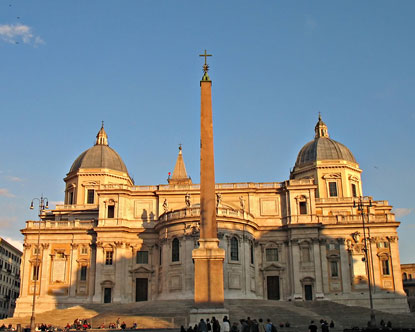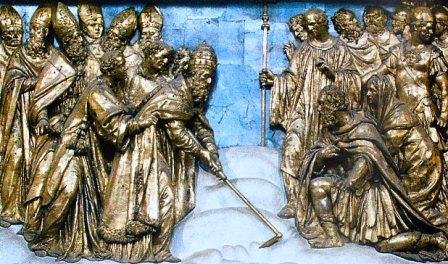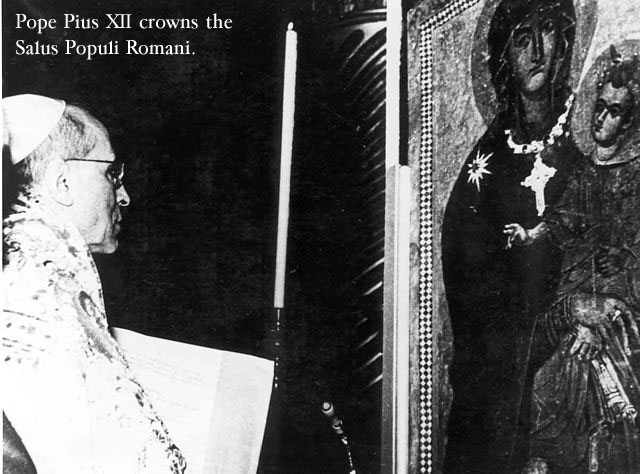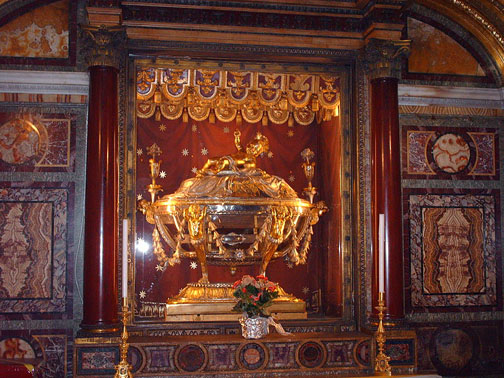

Rome, delivered from slavery by St. Peter on the first of this month, today offers to the world a wonderful spectacle. On seven hills had pagan Rome set up her pageantry and built temples to her false gods; seven churches now appear at the summits on which Christian Rome rests her now truly eternal foundations.
By their very site, the Basilicas of St. Peter and of St. Paul, of St. Laurence and of St. Sebastian, placed at the four outer angles of the city of the Caesars, recall the long siege continued for three centuries around the ancient pagan Rome, while the new Christian Rome was being founded. St. Helena and her son Constantine, recommencing the work of the foundations of the holy City, carried the trenches further out; nevertheless, the churches which were their own particular work—the Holy Cross in Jerusalem and the Archbasilica of Our Savior on the Lateran hill—are still at the very entrance of the pagan stronghold, close to the gates, and leaning against the ramparts; just as a soldier, setting foot within a tremendous fortress which has long been under siege, advances cautiously, surveying both the breach through which he has just passed, and the labyrinth of unknown paths opening before him.
Who will plant the standard of Sion in the center of Babylon? Who will force the enemy into his last retreat, and casting out the vain idols, set up his palace in their temples? O Thou to Whom was said this word of the Most High: "Thou art My Son; I will Thee the Gentiles for Thy inheritance," Thou mighty One, with Thy sharp arrows routing armies, listen to the cry re-echoing from the whole redeemed world: "With Thy comeliness and Thy beauty set out, proceed prosperously and reign!" (Ps. 45) But the Son of the Most High has a Mother on earth; the song of the Psalmist inviting Him to the triumph extols also the Queen standing at His right hand in a vesture of gold; if it is from His Father that He holds His power, it is from His Mother that He receives His crown, and He leaves Her in return the spoils of the mighty. Go forth then, ye daughters of the new Sion, and behold thy King in the diadem wherewith His Mother crowned Him on the joyful day, when, taking possession through Her of the capital of the world, He espoused the Gentile race.
Truly that was a day of joy, when Mary, in the Name of Jesus, claimed Her right as Sovereign and Heiress of the Roman soil! To the East, at the highest point of the eternal City, She appeared on that blessed morning, literally like the rising dawn; beautiful as the moon shining by night; more powerful than the August sun, surprised to see Her tempering his heat, and doubling the brightness of his light with Her mantle of snow; more terrible than an army; for from that date, daring what neither Apostles nor Martyrs had attempted, and what Jesus Himself would not do without Her, She dispossessed the deities of Olympus of their usurped thrones. As was fitting, the haughty Juno, whose altar disgraced the Esquiline, the false queen of those lying gods, was the first to flee before Mary's face, leaving the splendid columns of Her polluted sanctuary to the only true Queen of earth and Heaven.

Forty years had passed since the days of Pope St. Sylvester, when the "image of Our Savior, depicted on the walls of the Lateran, appeared for the first time to the Roman people" (Breviary Lesson for the Feast of the Dedication of the Archbasilica of Our Savior). Rome, still half pagan, beheld today the Mother of Our Savior; under the influence of the pure symbol (of snow) at which she gazed in surprise, she felt die down within her the evil ardor which once made her the scourge of nations, whereas now she was to become their mother; and in the joy of her renewed youth she beheld her once sullied hills covered with the white garment of the Bride of Christ.
Even from the times of the Apostolic preaching, the faithful, who gathered in large numbers in Rome in spite of herself, knew the Blessed Virgin Mary and paid to Her in those days of martyrdom a homage such as no other creature could receive; witness in the catacombs those primitive frescoes of Our Lady, either alone or holding Her Divine Child, but always seated (as a Queen), receiving from Her place of honor the praise, messages, prayers or gifts of prophets, archangels and kings (Cemeteries of Priscilla, of Nereus and Achilleus, etc.) In the Trastevere, where in the reign of Augustus a mysterious fountain of oil had sprung up, announcing the coming of the Anointed of the Lord, Pope St. Callistus in 222 had built a church in honor of Her who is ever the true fountain of oil, the source whence sprang Christ, and together with Him all unction and grace. The Basilica raised by Pope Liberius, the beloved of Our Lady, on the Esquiline Hill, was not, then, the most ancient monument dedicated by the Christians of Rome to the Mother of God; but it at once took, and has always kept, the first place among Our Lady's churches in the City, and indeed in the world, on account of the solemn and miraculous circumstances of its origin.
Hast thou entered, said the Lord to Job, into the storehouses of the snow, or hast thou beheld the treasures of the hail; which I have prepared for the time of the enemy, against the day of battle and war? (Job 38: 22-23) On the 5th of August, then, at God's command the treasures were opened, and the snow was scattered like birds lighting upon the earth, and its coming was the signal for the lightnings of His judgments upon the gods of the nations. The Tower of David now dominates over all the towers of the earthly city; from Her impregnable position Our Lady will never cease Her victorious sorties till She has taken the last hostile fort. How beautiful will Thy steps be in these warlike expeditions, O Queen, whose standard, by the will of Thine adorable Son, must wave over the whole world rescued from the power of the accursed serpent. The ignominious goddess, overthrown from her impure pedestal by one glance of Thine, left Rome still dishonored by the presence of many vain idols. But Thou, all-conquering Lady, didst continue Thy triumphal march. The Church of Sancta Maria de Ara Coeli replaced on the Capitol the odious temple of Jupiter; the sanctuaries and groves dedicated to Vesta, Minerva, Ceres, and Prosperine hastened to take the title of One who had been shown in their fables under disfigured and degraded forms. The deserted Pantheon awaited the day when it was to receive the noble and magnificent name of Sancta Maria ad Martyres. What a preparation for Thy glorious Assumption is the series of earthly triumphs which this day inaugurates! The Basilica of Sancta Maria ad Nives (St. Mary of the Snows), called also the Liberian Basilica from its founder Pope Liberius, and also the Basilica of Sixtus, after Pope Sixtus III, who restored it, owes to this last the honor of becoming the monument of the Divine Maternity proclaimed at the Council of Ephesus; the name of St. Mary Mother, which it received on that occasion, was replaced under Pope Theodore I, who enriched it with its most precious relic—that of the Crib of Jesus—by Sancta Maria ad Praesepe. All these noble titles were afterward gathered into that of St. Mary Major, which is amply justified by the facts we have related, by universal devotion, and by the pre-eminence always assigned to it by the Sovereign Pontiffs. Though the last in order of time of the Seven Churches upon which Christian Rome is founded, it nevertheless ranked in the Middle Ages next to the Archbasilica of Our Savior; in the procession of the Greater Litanies on April 25th, the Roman Ordo assigned to the Cross of St. Mary's its place between that of St. Peter's and that of the Lateran. The important and numerous liturgical Stations appointed at the Basilica on the Esquiline testify to the devotion of the Romans and of all Catholics towards it. It was honored by having Councils celebrated and Vicars of Christ elected within its walls; the Popes for a short time made it their residence, and were accustomed on the Ember Wednesdays, when the Station is always held there, to publish there the names of the Cardinal Deacons or Cardinal Priests whom they had resolved to create.
 As to the annual solemnity of its dedication, which is the object of the present Feast, there can be no doubt that it was celebrated on the Esquiline at a very early date. It was, however, not yet kept by the whole Church in the thirteenth century, for Pope Gregory IX originally assigned this day as the Feast of the newly canonized St. Dominic. It was Pope Paul IV who in 1558 definitively fixed the Feast of St. Dominic on the 4th of August; and the reason he gave is that the Feast of the Dedication of St. Mary of the Snows having since been made universal and taking precedence over the other, the honor due to the Holy Founder might be put in the shade if his Feast continued to be observed on the same day. The Breviary of Pope St. Pius V soon after promulgated to the entire world the Office, of which the following are the lessons:
As to the annual solemnity of its dedication, which is the object of the present Feast, there can be no doubt that it was celebrated on the Esquiline at a very early date. It was, however, not yet kept by the whole Church in the thirteenth century, for Pope Gregory IX originally assigned this day as the Feast of the newly canonized St. Dominic. It was Pope Paul IV who in 1558 definitively fixed the Feast of St. Dominic on the 4th of August; and the reason he gave is that the Feast of the Dedication of St. Mary of the Snows having since been made universal and taking precedence over the other, the honor due to the Holy Founder might be put in the shade if his Feast continued to be observed on the same day. The Breviary of Pope St. Pius V soon after promulgated to the entire world the Office, of which the following are the lessons:
Under the Pontificate of Liberius, John, a Roman patrician, and his wife, who was of an equally noble family, having no children to whom they might leave their estates, vowed their whole fortune to the Blessed Virgin Mother of God, begging Her most earnestly and continuously to make known to them by some means in what pious work She wished them to employ the money. The Blessed Virgin Mary graciously heard their heartfelt prayers and vows, and answered them by a miracle.
On the Nones of August (August 5th), usually the hottest time of the year in Rome, a part of the Esquiline hill was covered with snow during the night. That same night the Mother of God appeared in a dream to John and his wife separately, and told them to build a church on the spot they would find covered with snow, and to dedicate it to the Virgin Mary; for it was in this manner that She wished to become their Heiress. John related this to Pope Liberius, who said he had dreamt the same thing.
He went, therefore, with a solemn procession of priests and people to the snow-clad hill, and chose the site of a church, which was built with the money of John and his wife. It was afterwards rebuilt by Pope Sixtus III. At first it was called by different names: the Liberian Basilica, St. Mary at the Crib. But since there are many churches in Rome dedicated to the Blessed Virgin Mary, and, as this one surpasses all other basilicas in dignity, and by its miraculous beginning, it is distinguished from them also by its title of St. Mary Major. On account of the miraculous fall of snow, the anniversary of the dedication is celebrated by a yearly solemnity on this day.
What recollections, O Mary, does this Feast of Thy greatest Basilica awaken within us! And what worthier praise could we offer to Thee today than to remind Thee of the graces we have received within its precincts, and implore Thee to renew and confirm them? United with our Mother-Church in spite of time and distance, have we not, under its shadow, tasted the sweetest and most triumphant emotions of the liturgical cycle, now nearing its end?
 On the First Sunday of Advent, it was here that we began the Liturgical Year, in the place most suitable for saluting the approach of the Divine Birth, which was to gladden Heaven and earth and manifest the sublime portent of a Virgin Mother. Our hearts were overflowing with desire on the holy Vigil of the Nativity, when from early morning we were invited to the bright Basilica, where the Mystical Rose was soon to bloom and fill the world with its fragrance. The grandest of all the churches which the people of Rome have erected in honor of the Mother of God, it stood before us rich in its marble and gold, but richer still in possessing, together with the portrait of Our Lady painted by St. Luke (Salus Populi Romani), the humble yet glorious Crib of Jesus, of which the inscrutable designs of God have deprived Bethlehem. During the blessed night of the Nativity, an immense concourse of people assembled in the Basilica awaiting the happy moment when the monument of the love and humility of the God-Man was to be brought in, carried on the shoulders of the priests, like an Ark of the New Covenant, whose welcome sight gives the sinner confidence and makes the just man thrill with joy. A few months passed away, and we were again in the noble sanctuary, this time compassionating our Holy Mother, whose Heart was filled with poignant grief at the foresight of the Sacrifice which was about to take place. But soon the august Basilica was filled once more with new joys, when Rome justly associated with the Paschal Solemnity the memory of Her, who more than all other creatures, had merited its joys, not only because of the exceptional share She had in all the sufferings of Jesus, but also because of the unshaken faith wherewith, during those long and cruel hours of His lying in the tomb, She awaited His Resurrection. Dazzling as the snow which fell from Heaven to mark the place of Thy predilection on earth, O Mary, a white-robed band of neophytes coming up from the waters of Baptism formed Thy graceful court and enhance the triumph of that great day. Obtain for us all, O Mother, affections as pure as the white marble columns of Thy beloved church, charity as bright as the gold glittering on its ceiling, works shining as the Paschal Candle, that symbol of Christ the Conqueror of death, which in ancient times offered Thee the homage of its first flames.
On the First Sunday of Advent, it was here that we began the Liturgical Year, in the place most suitable for saluting the approach of the Divine Birth, which was to gladden Heaven and earth and manifest the sublime portent of a Virgin Mother. Our hearts were overflowing with desire on the holy Vigil of the Nativity, when from early morning we were invited to the bright Basilica, where the Mystical Rose was soon to bloom and fill the world with its fragrance. The grandest of all the churches which the people of Rome have erected in honor of the Mother of God, it stood before us rich in its marble and gold, but richer still in possessing, together with the portrait of Our Lady painted by St. Luke (Salus Populi Romani), the humble yet glorious Crib of Jesus, of which the inscrutable designs of God have deprived Bethlehem. During the blessed night of the Nativity, an immense concourse of people assembled in the Basilica awaiting the happy moment when the monument of the love and humility of the God-Man was to be brought in, carried on the shoulders of the priests, like an Ark of the New Covenant, whose welcome sight gives the sinner confidence and makes the just man thrill with joy. A few months passed away, and we were again in the noble sanctuary, this time compassionating our Holy Mother, whose Heart was filled with poignant grief at the foresight of the Sacrifice which was about to take place. But soon the august Basilica was filled once more with new joys, when Rome justly associated with the Paschal Solemnity the memory of Her, who more than all other creatures, had merited its joys, not only because of the exceptional share She had in all the sufferings of Jesus, but also because of the unshaken faith wherewith, during those long and cruel hours of His lying in the tomb, She awaited His Resurrection. Dazzling as the snow which fell from Heaven to mark the place of Thy predilection on earth, O Mary, a white-robed band of neophytes coming up from the waters of Baptism formed Thy graceful court and enhance the triumph of that great day. Obtain for us all, O Mother, affections as pure as the white marble columns of Thy beloved church, charity as bright as the gold glittering on its ceiling, works shining as the Paschal Candle, that symbol of Christ the Conqueror of death, which in ancient times offered Thee the homage of its first flames.
Thus the Basilica of St. Mary Major is the stational church—i.e. the church where the official liturgy is celebrated in Rome—on the following days: the First Sunday of Advent, all the Ember Wednesdays, the Vigil of the Nativity, the Midnight Mass of Christmas (at the altar of the Crib), the Mass of Christmas Day, the Feast of St. John the Evangelist, Wednesday of Holy Week, the Feast of the Resurrection, Rogation Monday, and in ancient times the Easter Vigil. For another article on Our Lady of the Snows see Salve Maria Regina No. 114.
Contact us: smr@salvemariaregina.info
Visit also: www.marienfried.com